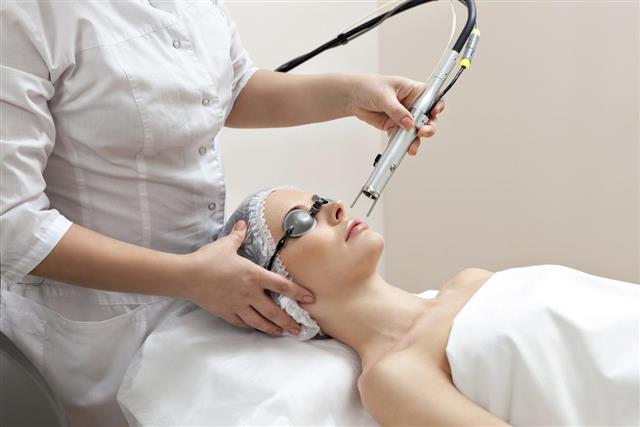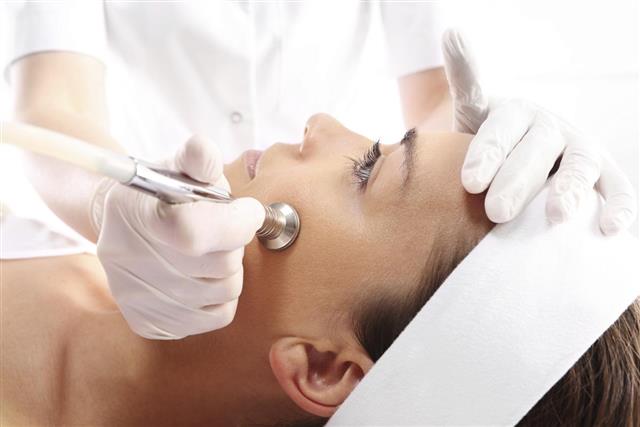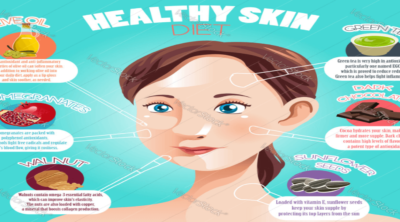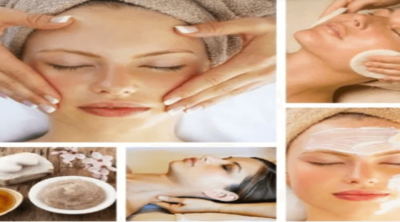
Laser surgery is emerging as a leading treatment option for acne and acne scar removal. The methods basically rely on the application of laser beams to help eliminate both acne and the resulting scars.
Quick Tip
To speed up the healing process, post surgery, cleaning up the acne-treated area with either saline or diluted vinegar, about five times a day, is recommended. Likewise, application of Vaseline jelly is an excellent way of forbidding the scabs from forming.
Acne is a common skin condition, especially among adolescents. Acne is generally caused by an oversecretion of sebum or oil by the sebaceous glands, which in turn, is stimulated by excess production of testosterone. This excess oil produced by the glands builds up in the skin pores, leading to the development of acne or pimples. Sometimes, this condition can create a favorable environment for bacterial growth, which eventually causes inflammation and pain. The common treatment for this condition includes laser treatment to remove the acne and its scars, among other options.
Surgical Options
Laser is actually an acronym for Light Amplification by Stimulated Emission of Radiation. Therefore, laser surgery involves the use of laser beams to dig the very core of the acne, in order to clear the clogged pores. It can effectively destroy the bacteria and the specific glands secreting excess sebum. However, the effectiveness of this process, to a great extent, depends on several factors, including the skill of the surgeon or the dermatologist. Sometimes, this surgery may require several sessions, as it may not be able to deal with all the glands and bacteria at one time.
Acne can be problematic even after its disappearance, as often, ugly scars are left behind, which are actually a result of the natural process of healing. Laser treatment or resurfacing is considered to be one of the most effective ways to get rid of these scars, mainly due to its precision and accuracy. There are two types of laser treatment; ablative and non-ablative.
Nonablative laser
Pulsed dye laser (PDL)
Potassium titanyl-phosphate (KTP) laser
Intense pulsed light (IPL) devices
Diode lasers
Neodymium-doped yttrium aluminum garnet (Nd:YAG) laser
Er:Glass laser
Smoothbeam laser
This method relies on triggering changes within the dermis by heating the collagen. This, in turn, tightens the skin and makes the scars less visible. The process does not cause any injury to the epidermis or outer layer of the skin unlike the ablative laser method. However, application of topical anesthetic cream is required before starting the procedure.
There is no permanent cure for acne, and hence, most of the treatment options are directed towards the alleviation of the symptoms like swelling, redness, and pain. For mild to moderate acne, the most commonly used over-the-counter medication is benzoyl peroxide, which is an antibacterial agent. Azelaic acid, retinoids like adapalene, and antibiotic lotions such as clindamycin (e.g. Dalacin T) or erythromycin (e.g. Stiemycin) are other medications for topical application. However, for treating inflammatory acne, oral antibiotics like tetracycline may be required.
In females, hormonal acne treatment has shown promising results in acne control or its prevention. Generally, these hormonal treatment methods aim at suppressing the level of the male hormone — androgen, which is responsible for stimulating the sebaceous glands to secrete excess sebum or oil. Sometimes, cortisone injections are used to treat stubborn and acute acne, especially when all the other treatment options fail to give the desired results. However, in recent times, one of the most talked about treatment option are the above-mentioned laser surgeries, which can be used for both acne and acne scar removal.
- Tanning
- Over exfoliation
- Teasing the acne
- Dryness of the skin (use a moisturizer)
- Overenthusiastic use of skin products
Boys go through severe acne between 16 to 19 years of age.
Shaving can, many a time, cause folliculitis, which often appears like acne.
About 25 to 30% of men suffer from acne.
Women
Severe acne erupts during the age of 14 to 17 years.
Approximately 50% of women have acne, and this percentage increases during pregnancy.
About 14% of women over 40 are hounded by acne.
Like all types of surgical treatment, laser surgery also involves some common surgical risks, like burning and an uneven appearance of skin due to inconsistent application of lasers. Its cost can also be quite significant. Moreover, this treatment may not be able to address the underlying causes required for acne prevention. Besides these, all individuals may not be suitable for this treatment. Therefore, all these issues should be properly discussed with an experienced dermatologist to evaluate all the aspects, before opting for such a surgery.
Disclaimer: This BeautiSecrets article is for informative purposes only, and should not be used as a replacement for professional medical advice.





